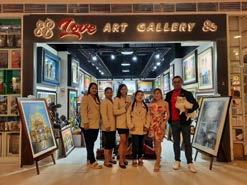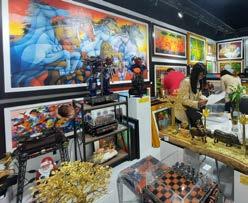M A G A Z I N E
Ar ts • C u ltu re • L iv in g

M A G A Z I N E
Ar ts • C u ltu re • L iv in g
Discover the art of capturing depth and perspective in landscape painting
Behind the Canvas: Spoliarium by Simon Peñaflor
Treat yourself with artworkshops and retreats

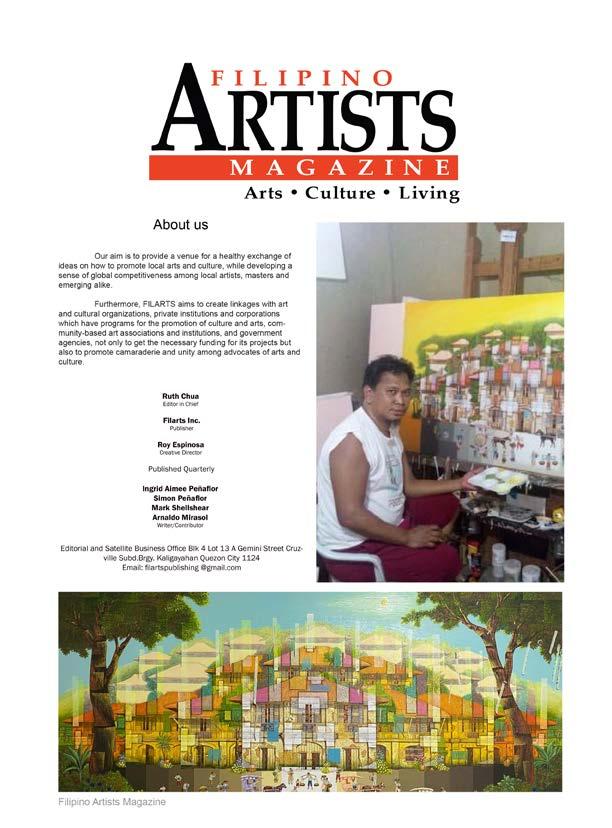
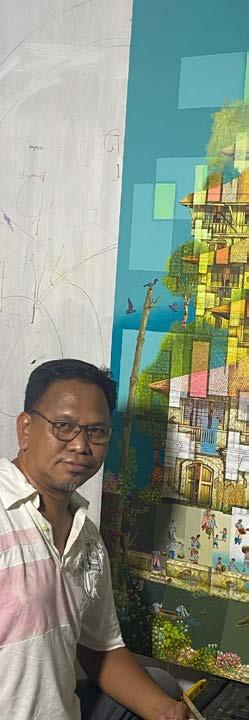
Page 4
Ingrid Aimee: The Life of an Average: A Beautiful symphony of connection
Page 6
5 secrets to painting atmosphere in landscapes you need to know
Page 8
Discover the art of capturing depth and perspective in landscape painting
Page 12
The Blanco Lagacy: A family's artistic journey through genertions
Page 20
A simple guide for stretching your own canvas
Page 24
Treat youreself with art workshops and retreats.
Page 30
Cover Story
A Journey of passion and dedication: Manuel Sinquenco
Page 40
Behind the canvas: Spoliarium Simon Peñaflor
Page 42
Colores dela vida opening day Ingrid Aimee Peñaflor
Page 60
Celebrating life and color: a week of art and friendship at Colores dela vida 2024
By: Ingrid Aimee

Friendship is a beacon of light that guides us through life’s twists and turns, a shining thread that connects our hearts and souls. In this intricate tapestry of human connection, art weaves its colorful threads, adding depth, beauty, and meaning to the bonds we share with our friends. The relationship between art and friendship is a harmonious dance of creativity, emotion, and shared experiences, creating a beautiful symphony of connection that resonates deep within our beings.
At the heart of every friendship lies a shared love for the arts. Whether it’s painting, writing, music, or dance, creativity is the glue that binds friends together, providing a canvas for self-expression and a stage for emotional exploration. Through art, friends can communicate in ways that transcend words, expressing thoughts, feelings, and experiences that words alone cannot capture. It is through the strokes of a brush, the melody of a song, or the rhythm of a dance that friends can truly connect on a soul-deep level, sharing a language that speaks to the core of their beings.
The act of creating art together is a powerful way for friends to strengthen their bond, collaborate, and share in the joy of creative expression. Whether it’s painting a mural, writing a song, or collaborating on a theatrical performance, the act of creating art together fosters a sense of unity, trust, and mutual understanding. Through the process of co-creating,
friends learn to appreciate and celebrate each other’s unique strengths, talents, and perspectives, deepening their connection and creating lasting memories.
Art also serves as a mirror that reflects the beauty, pain, and complexity of the human experience, providing friends with a window into each other’s inner worlds. By engaging with different art forms and exploring diverse perspectives, friends can cultivate empathy, understanding, and appreciation for one another’s unique journeys. Art challenges us to see the world through new eyes, to embrace vulnerability and authenticity, and to connect with the depths of our shared humanity. In this way, art has the power to broaden our horizons, deepen our emotional connections, and foster a sense of empathy and compassion within our friendships.
Moreover, art has a transformative power to heal, comfort, and uplift the spirits of friends in times of joy, sorrow, or uncertainty. Through engaging in art therapy activities, such as painting, crafting, or attending a concert, friends can find solace, release, and rejuvenation in the creative process. Art becomes a sanctuary where friends can express their emotions, process their thoughts, and find a sense of peace and comfort amidst life’s challenges. In this way, art not only deepens the bond between friends but also provides a source of strength, resilience, and support in times of need.
In conclusion, the relationship between art and friendship is a profound and beautiful one, enriching our lives in ways that are both simple and profound. Through the power of creativity, expression, and connection, art and friendship create a symphony of human connection that elevates our spirits, deepens our bonds, and nourishes our souls. As we continue to nurture our friendships and engage with the transformative power of art, we cultivate a more empathetic, connected, and vibrant world—one where the beauty and joy of human connection shine brightly, like a beacon of light guiding us through life’s journey.
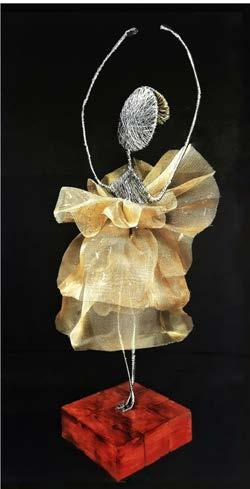

McKenzie Graham
Paint the ever-elusive atmosphere in a way that truly expresses your personal connection to a place and time.
As a landscape painter in the United Kingdom, artist Oliver J. Pyle is engaged by the idea of atmosphere and how it relates to painting, using watercolor. Read on to uncover Pyle’s five secrets for creating compelling scenes and atmosphere that have the power to capture the viewer’s eye —and heart. Enjoy!
The Evocative Landscape
I love painting landscapes and everything about it. And watercolor allows me to make my own response to what I see and feel. Specifically, certain landscapes in the U.K. have become favorites because of proximity or family holidays. I know their vistas and details intimately. With that being said, why is it that some paintings are deemed to be atmospheric, while others aren’t? Atmosphere in a painting is, with a few exceptions, not about technique. First and foremost, it’s your connection to the place that matters.

On numerous occasions, I’ve walked along a particular beach in Dorset, where I’ve built sand castles, played cricket, and swam in the sea. I’ve been sunburnt by lounging on it for too long, and have sat looking across the bay, shivering, while drinking a cup of tea. I feel as though I know everything about the place.
In painting A New Day, Studland, I hoped to translate that experience into brushstrokes so that viewers can, in some way, experience what it’s like
to be there. If I’m successful in this endeavor, then I believe the painting has atmosphere — a true sense of the place and the time, if you like. If you’re in love with your subject, and spend time getting to know it and understand it, then it’s very likely your work will have this elusive quality.

The best way to turn an otherwise ordinary scene into something compelling and atmospheric is to tell a story. Consider a subject like Elizabeth Tower (also known as Big Ben). It’s probably London’s most iconic landmark, to the extent that its familiarity can work against an artist. My reference photos and sketches for Eventually the Rain Stopped, a studio painting of Parliament Square featuring Big Ben, were from overcast days, saying nothing new or interesting about the scene. To bring the scene to life, I needed a story.
Having played around with a few sketches and ideas, I felt that wet pavement and reflections, with a break in the oh-so-British weather, would help to create interest. The inclusion of people walking into the painting and toward us gives a sense there’s some early-evening movement to get to the underground station — or even to attend a late session of Parliament — now that the rain has stopped.
3. Use the Light
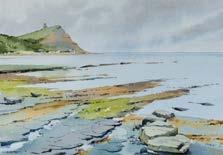
More often than not, artists think it’s difficult to create drama and atmosphere without strong sun light and deep shadows. In the U.K., however, strong directional light can be something of a rarity. Dull, overcast days are far more commonplace. Stormy Light, Kimmeridge Bay benefits enormously from the flat lighting and brings back strong memories of the day I was there.
I watched children search for fossils and hermit crabs in the rock pools before making a retreat to the warmth of a local tea room. I couldn’t help but notice how the bright greens and oranges of the seaweed contrasted with the cool slate gray of the ledges that jut out into the bay. With strong highlights and deep shadows, the effect wouldn’t have had the same impact. Color was far more important than tonal contrast. While light is an essential part of the toolkit in creating atmospheric paintings, understand what it is about the light that makes a scene compelling. It doesn’t need to be high contrast. Many wonderful paintings have been made on an overcast day.
I hinted at the outset that it was primarily the artist’s connection with a subject — not technique — that leads to atmospheric paintings. Does that mean technical issues aren’t important? Of course not. Hopefully, a couple of pointers from Colours of Tuscany will be helpful.
It features a well-known area in Italy, and the undulating landscape is home to many wonderful vineyards. These present a challenge. They add a level of detail to the hillsides and need careful handling.
4. Understand Your Technique

Painting them in detail would be a mistake. It would spoil the atmosphere that comes from the strong but hazy light and the depth in the landscape. For passages such as this, the simplest of brushstrokes to create broken washes, as well as a sound drybrush technique, are all that’s required to suggest rows of vines in the distance. The foreground vines are painted wet-into-wet. It’s just enough to suggest vines without lots of hard edges to distract us from the main subject — the charming villas.
To help build atmosphere in your work, try to simplify and reduce what you see to as few brushstrokes as possible. Something suggested rather than stated creates a more satisfying experience for the viewer — and helps to ensure your story or vision isn’t shouted down by distracting details. Make sure you have firm control over both color and tone; they’re vital in creating atmospheric paintings.
We’ve seen how to create atmosphere, but exactly what is it? I think Evening Haze, Kimmeridge Bay helps to get to the crux of the concept. The painting is of a scene on the Dorset Coast with which I’m very familiar. This is one of my favorite paintings — the evening light; the calm, silvery sea; the focal point of Clavell Tower; the sheep; the receding cliffs in the distance. It’s so redolent of my experiences in this beautiful part of the country. I find it incredibly evocative.
To me, atmosphere is nothing more than a true sense of a place and time. Presenting that for others to experience and enjoy is truly satisfying and is often why viewers engage with a particular painting. Of course, it’s very subjective, too. A painting may not evoke the same emotion in one person that it does in another. Generally, though, if a piece of art is able to draw viewers in — to make them enter into the experience of being there at that moment in time — then it’s undoubtedly an atmospheric painting.
Learn more about Oliver J. Pyle and see more of his work at OliverPyle.com and on his Instagram page, @ watercolour_olly.
By Vladislav Yeliseyev
Whether working en plein air or from photographs, landscape painters have to grapple with an almost boundless source of information. It’s a blessing and a curse. The sheer volume of it all can become overwhelming and make it a challenge to decide what to incorporate, what to edit out, and how to organize everything into a meaningful and impactful work of art. With the myriad considerations a landscape artist must keep in mind, an understanding of how to effectively employ a three-planes-of-vision concept is an invaluable asset.
Our perception of reality is three-dimensional. The challenge of painting, however, is to convey a twodimensional representation on a flat surface while creating the illusion of depth. Therefore, our aim as artists is to establish visual separation among these three planes in our composition. This is where the three methods of painting on each individual plane come into play.

I painted Appalachian Farm (watercolor on paper, 12×16) using a drybrush technique with reduced contrast. The small section of the foreground barrier doesn’t draw much attention, and the background plane was painted to appear flat. I made a deliberate decision to relocate the tree, which was originally next to the barn, to the midground plane, painting it with high contrast to enhance the composition. Break It Down
When it comes to composing and finalizing a landscape, the key lies in simplification. Breaking down the scene into three distinct planes is a practical approach that offers manageability. While, theoretically, one could incorporate as many planes as desired, attempting to control them all would become a convoluted endeavor resulting in a chaotic hierarchy of elements in the composition.
A fundamental and highly effective technique for dividing a landscape into planes is to envision three vertical flat surfaces neatly stacked in succession. Each of these surfaces represents a two-dimensional picture capturing a specific portion of the entire image. The farthest surface constitutes the background, portraying elements of the landscape that are most distant within the picture. Think of it as the backdrop in a theater set, playing a supporting role in the overall production. The plane, moving forward, represents the midground,
encompassing the focal area and immediate surroundings as perceived by the artist. The nearest plane, closest to the artist, forms the foreground, which contains all the immediate details and information.
This method is straightforward. Paint each plane as a flat surface without concerning yourself with the need to convey three-dimensionality on each one. Stacking these three flatly painted planes against one another will be enough to generate a sense of depth in the painting.
For the background plane, employ a wet-on-wet painting technique, featuring soft edges, light washes, and muted colors to mimic atmospheric perspective. The use of water bottle sprayers can be quite advantageous in this stage.
The midground plane, featuring the focal area, benefits from high contrast, bold brushwork, and intense color mixes to draw the viewer’s attention. These two planes alone can effectively create a sense of depth. In reality, we seldom pay attention to our nearest, most immediate surroundings, instead focusing most of our attention on the midground, where the action tends to unfold. Therefore, the level of detail in the foreground plane should be reduced by utilizing the drybrush method. This implies a suggestive approach that distinctly contrasts with the background’s appearance.

To capture the bustling Parisian streetscape in Gaumont Opera (watercolor on paper, 14×19), it was crucial to simplify the scenery into three planes. The foreground featuring the Gaumont Opera Cinema
building was painted loosely using a drybrush technique, while the middle building received all the light and contrast.
Every artist perceives the landscape differently. What holds interest for one may hold none for another, and vice versa. Every individual brings their unique perspective and impressions to the canvas. Consequently, the placement of the planes of vision may vary from artist to artist. This is both expected and acceptable, as long as the consecutive order of the planes hasn’t been broken.
One important step in determining the placement of planes is the creation of a monochromatic sketch, whether it be graphite or grisaille. This diversity in perception is one of the reasons why, even within a group of artists painting the same scene, the end results can be strikingly distinct irrespective of skill level.

Three planes of vision have been clearly distinguished in Sarasota Harbor (watercolor on paper, 14×10). The buildings in the background are painted as a flat, undetailed backdrop, and the promenade pier in the foreground is lightly drybrushed with minimal detail, which keeps viewers’ attention on the boats in the middle ground.
It’s my hope that this method will assist other artists in approaching their own unique landscape paintings with a professional and simplified methodology. Learning how to recognize the planes of vision and organize them into a composition will not only enhance your painting process but eventually help you to master other painting techniques as well.
Follow along as I use the three planes of vision to create a Venetian water scene.

Step 1: I created a sketch to serve as reference for a full-color painting. It was useful not only as a value study, but also as a clear display of the separation between the background, midground and foreground planes with their respective brushwork execution.

Step 2: I applied light washes to de-emphasize contrast and color in the background plane. Note the very low contrast between the background building and the sky. The colors I used were mixed with a significant amount of water.

Step 3: High contrast and bolder colors were implemented in the midground area to draw attention to this plane. This focal area draws the viewer’s attention, as it’s where the main action takes place, so it’s lit accordingly brightly.

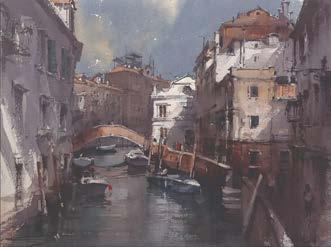
Step 4: I applied a preliminary wash in the foreground area before adding drybrush details. I took this step to reduce the contrast in the foreground plane.
Final Step: To complete Venice Canal (watercolor on paper, 14×19), I added half tones of drybrushed local watercolor washes before applying a unifying wash to the foreground area to further diminish the contrast, in addition to adding details using titanium white gouache mixed with a slight amount of yellow ochre to warm its color temperature. This was done to increase the sense of texture on the walls, along with slight indications of windows in the background building.
Vladislav Yeliseyev is a sought-after educator in the watercolor and plein air communities. He conducts virtual, plein air, and studio workshops in addition to hosting art holidays in Europe. The artist holds Signature Memberships in the American Impressionist Society and the National Watercolor Society.

Nestled in the heart of Angono, Rizal, creativity flows like a shared language among the Blancos. This family, which consists of four artists, is a perfect example of how talent, tradition, and creativity can coexist. They are a household of visual artists who become one with their own canvases in order to bring their visions to life. Their dedication to this timeless medium has earned their place in the Philippine art scene, where their works are appreciated for their depth, vibrancy, and storytelling. The Blanco family, renown for their contributions to the visual arts, has turned their shared passion into a creative lineage, each member adding their unique flair to the family’s
growing legacy. They have transformed their home into a living gallery where each artwork reflects their passion. Although each of them contributes a distinct viewpoint to the canvas, there is a connection between their pieces, whether it be their shared affection of nature, their shared heritage of culture, or their ability to convey unfiltered emotion through art.
They stand as a testament to the town’s enduring cultural heritage. Led by Jan Perez Blanco, they have not only preserved but also elevated the rich traditions of Filipino art, weaving a narrative that binds generations while celebrating each of their own individuality.

Jan Perez Blanco, the patriarch of a family of artists, has been captivating audiences with his talent from even at a young age. His works often explore themes of cultural identity and social consciousness, capturing the spirit of the Filipino people on canvas. Jan Perez Blanco’s artistic journey began with the guidance of his father, Jose "Pitok" Blanco, a renowned artist and nominee for the Order of National Artists. In 1977, at just five years old, Jan started painting alongside his older siblings. Initially, Jose hesitated to teach his children, wary that a career in the arts might lead them to face the same challenges he did as a fine arts graduate. However, witnessing their natural talent and passion, he chose to nurture their abilities, with Jan among the youngest learners. This early mentorship instilled in Jan a profound love for art and a d etermination to carve his own path. With just a young age of seven, Jan Blanco gained early acclaim when he won an award at the 1979 International Sand Sculpture Competition in Acapulco, Guerrero, Mexico. Then in 1981, he and his sister were also honored with an award at the 3rd International Children’s Art Exhibition and the Exhibition of Disabled Children in Hong Kong. Jan Blanco started his interests with painting feathered creatures, capturing their intricate details with remarkable realism. Through painting them, he has discovered their poetic beauty. His meticulous attention to detail not only brought his subjects to life but also honed his skills as an artist. As his expertise and knowledge evolved, he expanded his repertoire to also explore other subjects, such as numerous faces and life-sized figures. Following in his father’s
footsteps, Jan Blanco has also embraced themes of domestic life and local traditions, including the spirit of religious festivals. His artworks resonate with a deep connection to Filipino culture, vividly portraying the rhythms of everyday life and the essence of community
Jan Blanco’s painting, Smokey Mountain, became a cultural touchstone as it bridges the worlds of visual art and music. During a visit to the Blanco family museum, National Artist for Music Ryan Cayabyab encountered the painting, and let’s say one may have inspired the other. Seemingly, it led him to conceptualize a musical group of the same name. The group, Smokey Mountain, went on to popularize the hit song Paraiso. Adding to its legacy, Jan Blanco’s painting appeared on the back cover of the Paraiso album, solidifying its significant influence on both art and music in the Philippines. Jan Blanco’s works have been featured in both local and international exhibitions since he was just six years old, starting with a showcase at the National Museum of the Philippines. In the Philippines, his art has been displayed in prominent venues across Manila, Makati, Pasig, Laguna, and Cebu. Internationally, his talent has also brought him to exhibits in The Hague, the Netherlands; Xiamen and other cities in the People’s Republic of China; Sentosa Island, Singapore; San Francisco, California; Washington, D.C.; New York City, New York; Los Angeles, California; State of Hawaii; and Seville, Spain. With each piece he brought, there’s a testament to his ability to blend technical skill with emotional depth.

Beside Jan stands Jaz Guañez Blanco, a talented artist in her own right and an indispensable part of the family’s creative journey. From when her children were young, Jaz made sure they had all the art materials they needed. She’d supply them with reams of paper, knowing they’d go through it quickly as they poured their ideas onto it. Over time, she began to keep their sketches, preserving these early expressions of the children’s visions. With this, she found inspiration in the artistic growth of her children, realizing that she, too, could refine her own skills in visual arts. As she assisted with the family’s art workshops, Jaz Blanco

was also immersed in the creative environment. She not only helped others but also learned alongside them. It was in this space, surrounded by like-minded individuals, that she was able to truly hone her craft and deepen her artistic abilities.
Jaz Guañez Blanco’s journey into the arts has its own uniqueness. She found another form of self-expression by painting on the wooden molds used for crafting shoes. As a background, her family, while from Binangonan, Rizal, was in the shoe business in Marikina City, a thriving hub for quality footwear. This unconventional canvas ignited her creativity and became her gateway into the visual arts. Her paintings on these shoe molds often feature vibrant landscapes, floral scenes, and depictions of the Higantes Festival in Angono, celebrating the cultural heritage of the Blanco family. In many ways, this became her personal homage to her family in Angono, as well as her family’s shoe business story. Jaz’s passion for painting was
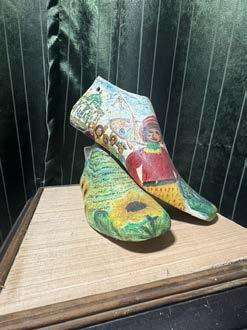
further enkindled by Jan’s exhibits, where she had found more inspiration. She then continued her work on blank canvases to project her own vision and creativity. Aside from Visual Arts, Jaz Blanco also found heart at the Art of Cooking. She discovered that cooking provided the perfect platform to merge her passions and talents in a way that felt complete and organic. It allowed her to blend visual beauty with the tactile, sensory experience of food. Her journey is a reminder that creativity isn’t limited to not just one medium; it can evolve across different disciplines. Through cooking, she also found space where she could express her artistic vision while also nurturing, sharing, and connecting with others on a deeper level.
Jan Lemuel Blanco, the eldest son of the Blanco family, discovered his passion for art at the young age of two. With crayons, pencils, and markers in hand, he would sketch the sights that look fascinating from the perspective of a child. This includes fiestas, fluttering butterflies, and his favorite: flowers. His early works reflected a natural sense of curiosity, each piece characterized by the spontaneous creativity of his youth. Jan Lemuel’s early artistic development was partly influenced by his grandfather, Jose "Pitok" Blanco. Around the age of seven or eight, under Jose’s

guidance, Jan Lemuel began painting his own version of a landscape inspired by his grandfather’s work. This mentorship helped him gradually refine his unique style. However, their collaborative work came to a halt by Jose’s passing, leaving Jan Lemuel’s painting unfinished, with only 20% of it done. After his grandfather's passing, Jan Lemuel found himself at a crossroads. While grief played a part, it was also a sense of uncertainty about his artistic path that led him to explore other forms of expression. He turned to theatre and singing, discovering more new ways to channel his creativity and emotions. Though his focus shifted to the stage, his passion for painting and the visual arts never really faded.
After a decade, Jan Lemuel experienced a renewed sense of purpose that led him back to painting. With a deeper understanding of his craft, he returned to the landscape painting he had once started. Completing the piece felt like a quiet return to
one of his roots, a way to not only honor his grandfather’s influence but to also continue a creative tradition that still had meaning for him. Jan Lemuel has received numerous accolades from various organizations. These include the Natatanging Mamamayan sa Sining at Musika award in 2012 for Music and Visual Arts, arecognition as a Youth Ambassador for the Municipality of Angono, and a prestigious honor at the 2024 Celebrating Rising Excellence in Artistic Talent and Expression (CREATE) Awards by the House of Representatives of the Philippines—Arts, Culture, and Creative Industries Bloc, in the visual arts category. Jan Lemuel is a Magna Cum Laude graduate with a B.A. in Fine Arts, Major in Painting degree from the University of Santo Tomas. He combines his deep academic roots with a passion for teaching art. Also recognized with a Merit in Thesis for his outstanding work, he is dedicated to making art more accessible to a wider audience. His interests in Museology and Art Conservation reflect his commitment to preserving and sharing the rich legacy of artistic expression. While he appreciates the craft of painting, his passion also lies in the art of custodianship. With a deep commitment to preserving heritage, he focuses not only on conserving the legacy of the Blanco family but also on honoring the rich cultural heritage of the Filipino people. Jan Lemuel recognizes that his artistic interests are not limited to the Blanco style. He aspires to enrich the family legacy by introducing his own visions, ones that reflect and serve as a mirror to contemporary society. While the Blanco family, starting from his grandfather, Jose Blanco, has masterfully portrayed traditional narratives through their art, Jan Lemuel feels a deep calling to tell the stories of today
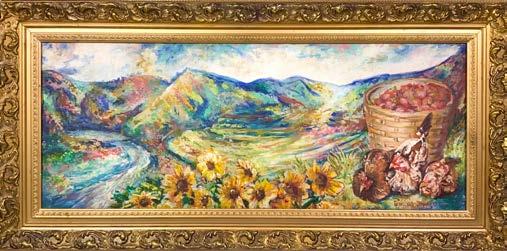

Justin Jan Blanco, the youngest member of the Blanco family, continues the family’s artistic legacy with a fresh and youthful perspective. He began painting at a young age, and one of his early works when he was 6, which is a painting of a bird, was even featured in his father’s exhibit in New York City. Over time, Justin’s passion for art grew, with cats becoming a favorite subject, reflecting his deep affection for them. His father, Jan Blanco, even notes that Justin’s brushstrokes bear a striking resemblance to his own, further linking their shared artistic journey.
Currently, Justin is exploring themes related to technology, including electronics and engineering. His work blends the traditional techniques he learned from his family with modern subjects, creating a unique fusion of the past and present. For him, focusing on his own interests isn’t a betrayal from his roots, but an extension of them. It is his way to innovate, expound, and create. Merging science and art in a way that feels deeply fulfilling without straying away from what he grew up with. Justin realized that his artistry isn’t limited to one medium. Whether through painting or electronics, he can push the boundaries of his creativity.
Through his art, Justin continues to honor the family’s legacy while carving out a distinct path and identity of his own.
The Blanco family has made a profound impact on Angono’s artistic heritage, building on the legacy established by Jose "Pitok" Blanco decades ago. As the family continues to create, their works serve as bridges between three generations, linking the old with the new. They remind us that art is not just a reflection of life but also a force that shapes and sustains it.
In Angono, the Blanco family’s legacy is not merely preserved on canvases but etched into the fabric of the community’s identity. Each member brings their own unique perspective, blending the traditional Blanco style with contemporary visions, further enriching the tapestry of the Philippine Art Scene.
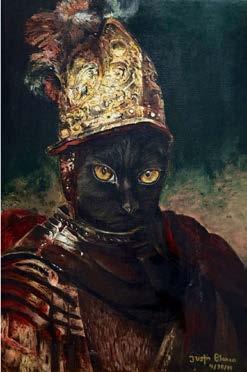
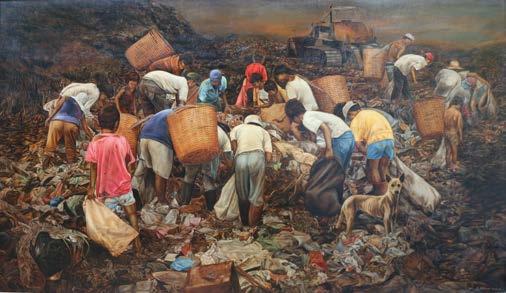


Levi Yu, born on August 26, 1980, in Davao Oriental, is a distinguished Filipino artist whose creative journey reflects a profound connection to his roots and a relentless pursuit of artistic excellence. As the eldest son of William and Emma Yu, and the brother of Boots Christine and Billy Israel Yu, Levi's artistic endeavors are deeply influenced by his familial ties and personal experiences. Currently married to Mrs. Bonna Carmelo Yu, Levi resides at 10-F St. Ignatius Street, San Jose Village, Alabang, Metro Manila.
Levi's educational journey laid a solid foundation for his artistic pursuits. He graduated with a degree in Business Management with a focus on Entrepreneurship from St. Benedict College, Alabang Hill Village. His academic achievements speak volumes about his commitment to excellence, earning him the honor of being a constant Dean's Lister and Best in Thesis Awardee. Levi's academic journey culminated in being a top-ranking student, securing the 9th spot overall in the Batch of 2001.
Fluent in English, Bisaya, and Tagalog, Levi's linguistic skills mirror the diversity of his artistic expressions. His professional journey began as a Disciplinary Officer at Theresiana de Montealegre Dame School, Alabang Muntinlupa, from 2001 to 2002. Subsequently, Levi contributed his expertise as a Property Associate at Brittany Corporation from 2003 to 2008. In 2012, he embraced his passion for art as an Art Consultant at Art Circle Gallery, where he continued to thrive until 2020.
Beyond his professional accomplishments, Levi finds joy and inspiration in various hobbies, including drawing, computers, basketball, playing guitars, and listening to music. These diverse interests contribute to the multifaceted nature of his artistic vision.
Levi Yu's artistic journey is marked by a series of noteworthy exhibits and shows that showcase the depth of his talent. Notable among these are his one-man shows such as "PLACES" at Art Circle Gallery in October 2020 and "SECOND ONE_MAN SHOW" at Art Circle Gallery in Festival Super Mall Alabang on October 26, 2008. Levi's participation in group shows, fundraisers, and collaborations further demonstrates his commitment to contributing to the art community.

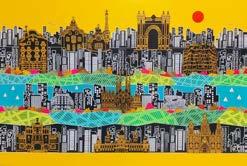
His work has not only been recognized in exhibitions but also featured in publications, cementing his place in the Filipino art scene. Levi Yu's art has been acknowledged in "Encyclopedia of Philippine Art" by Marlene Aguilar and "Different Faces of Mother and Child" by Carlos A. Arellano, among others.
Notably, Levi received recognition as a Finalist in the AAP Abstract Art Competition in 2007, solidifying his position as a respected figure in the art world. His dedication to abstract art and his ability to infuse his work with cultural influences make Levi Yu a noteworthy Filipino artist, contributing significantly to the rich tapestry of the country's art scene.
Levi's commitment to his craft is further reflected in his creative process. He begins with composition, meticulously considering how the parts of an image relate to each other to create a cohesive whole. This involves the strategic placement of objects on the picture plane and the relationships between these objects, all of which contribute to the expressive content of the image.
Another key aspect of Levi's technique is atmospheric perspective. He skillfully describes how objects that are close appear clear, while those that are farther away become blurred. This method not only adds depth to his paintings but also conveys his perception of space and distance. Levi's use of warm and cool colors further accentuates the atmospheric conditions of the scenes he portrays, whether it is summer, fall, winter, or spring. His ability to express emotions through color aligns him with artists like John Constable, Alfred Sisley, and Vincent van Gogh, who are known for their direct strokes and bright color palettes.
Throughout his career, Levi has remained dedicated to studying, investigating, and evaluating his work. His relentless pursuit of artistic excellence reflects his aspiration to inspire future generations.
By sharing his knowledge and insights, Levi hopes to contribute significantly to the field of art, ensuring that it continues to evolve and thrive. His works not only depict the progression of time but also serve as a source of inspiration and education for upcoming artists.
Levi Yu's journey as an artist is marked by his unwavering dedication, continuous experimentation, and deep-seated passion for art. His paintings are not only a visual delight but also a testament to his commitment to capturing the beauty and intricacies of everyday life. Through his art, Levi continues to inspire and influence the art world, leaving a lasting legacy for generations to come.


Scott Maier
Painting on pre-stretched, store-bought canvas is a quick and easy solution for many artists, but it comes with some limitations. You may decide that stretching your own canvas is what you need to maintain greater control. When just getting started, stretching your own canvas can be a bit challenging as you seek to understand the nuances of the canvas, stretcher bars, and primers. In this overview of the process, we’ll break down the essential aspects so you can make informed decisions about what will work best for you.
When it comes to canvas, one of the first considerations is weight. Canvas weight refers to the thickness and density of the fabric, typically measured in ounces per square yard (oz/yd²) or grams per square meter (gsm). Common weights range from lightweight (6-8 oz/yd²) to heavyweight (12-15 oz/yd²), with variations in between.
Linen and cotton are commonly used for painting surfaces. Linen canvas is known for its strength, longevity, and smooth surface, making it a preferred choice for professional artists. Cotton canvas is more affordable and versatile and offers a wide range of textures and finishes.
Lightweight canvas is ideal for smaller works, studies, or sketches, offering ease of handling and flexibility. Medium-weight canvas strikes a balance between stability and maneuverability and is suitable for most painting approaches. Heavyweight canvas provides more robust durability and stability for larger-scale works or heavy painting techniques.
Advantages of Artists’ Canvas over General Purpose:
While general-purpose canvas may work for casual or beginner projects, artists’ canvas offers several advantages that affect the quality and longevity of your work. Artists’ canvas is crafted with more precision and consistency, with greater care given to the surface weave and texture.
The surface of artists’ canvas is typically smoother and more uniform than general-purpose
canvas. This provides a better foundation for paint layers. Additionally, artists’ canvas is often pre-primed with gesso, making it ready to paint directly from the store.
Canvas needs to be stretched over stretcher bars primarily to create surface tension, ensuring a smooth and taut painting surface that prevents sagging or buckling. Stretcher bars also offer support and stability, preventing warping or distortion over time. Stretched canvas can be easily framed or displayed without additional mounting, with the edges painted or wrapped around the sides of the stretcher bars for a finished presentation.
There are several factors to consider when purchasing stretcher bars. High-quality artist-grade stretchers will be made with kiln-dried wood like pine, fir, or cedar and will be straight, with no warping or twisting. Thickness ranges from 3/4 inch (Standard) to 2 inches (Heavyweight); choose a thickness that suits the size and weight of your canvas. Additionally, consider the profile of the stretcher bars, whether standard, gallery wrap, or deep edge, depending on your aesthetic preferences and framing requirements. Stretchers are milled with mortise and tenon, or finger-jointed corners, that make them easy to assemble and come with keys that allow for adjusting tension.

Once the canvas has been stretched, it needs to be primed with gesso to ensure effective paint adhesion over time. Gesso—a mixture of chalk, gypsum, and binder—is painted onto the surface of the canvas to create a smooth, absorbent ground for painting. This primes and seals the fabric, preventing the paint from seeping into the canvas fibers. It also provides a toothed surface for paint adhesion and layering of paint.
Acrylic gesso has become the preferred choice for priming canvas due to its versatility, flexibility, and durability. Unlike traditional gesso, which is made from animal glue and gypsum, acrylic gesso is composed of acrylic polymer emulsion and calcium carbonate. Acrylic gesso dries quickly and provides a flexible yet durable surface that resists cracking, yellowing, and flaking over time. Additionally, acrylic gesso can be tinted or textured to suit specific artistic preferences, offering a range of possibilities.
For artists working with oil paints, traditional oil
painting ground, also known as oil primer, offers several advantages over acrylic gesso. Oil primer is typically composed of a mixture of linseed oil, pigment, and additives such as lead carbonate or titanium dioxide, and creates an absorbent surface that allows for strong adhesion, smooth blending, glazing, and impasto techniques.
Prior to applying oil primer, the canvas needs to be sized with polyvinyl acetate (PVA) sizing. PVA sizing creates a barrier between the canvas and oil ground, reducing the risk of deterioration and ensuring the longevity of your work.
With the right materials, preparing your own canvas can be rewarding and deliver a level of precision that is difficult to achieve with pre-stretched and pre-primed canvas.
Take some time and experiment with different canvas weights, stretchers, and primers to determine what works best for you and your painting approach. Do you stretch your own canvas?
Tell us what you use!
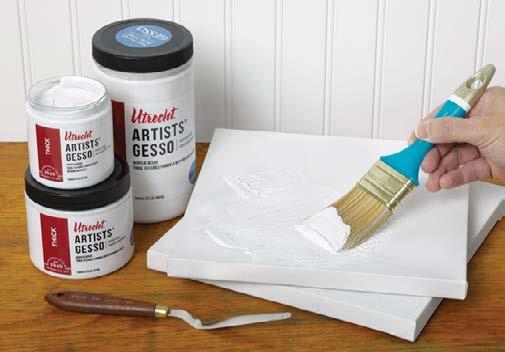

Join us for an enchanting evening as we present Ponce Veridiano's latest art exhibit, "A Breath Upon Nature," on Thursday, January 30, 2025, at 6 PM, at Warehouse 17, La Fuerza Compound, 2241 Pasong Tamo, Makati.
Ponce Veridiano's art practice is a deeply personal journey of meaning-making that intertwines emotion, artistic vision, and authenticity. His work is a testament to a decades-long career dedicated to creativity. For Ponce, art is not just a practice but an innate part of his being, fundamentally linked to how he experiences and interprets life.
Ponce's artistic versatility is evident in his diverse body of work, which encompasses landscaping, design, painting, and the seamless integration of these mediums. His latest series of works invites viewers to let their hearts unfold and engage their senses fully, much like walking through the tranquil forests and temples of Koyasan, the artist's recent source of inspiration.
In this collection, Ponce captures vibrant moments within nature's embrace. His paintings speak the language of colors, portraying the beauty of morning light and the calm of nightfall. Through masterful brushstrokes, he brings to life swaying bamboo, gentle raindrops, and the ancient roots of holy trees, creating a vivid and immersive experience for the viewer.
Ponce's newest works bring a fresh contemporary touch to gestural art. He allows the paint to convey emotions and sensations, making the experience of viewing his art more about feeling than telling a story. His approach prompts viewers to connect with their inner states of emotion, offering them brief glimpses of divine awe and beauty within nature.
This exhibit serves as a window into Ponce's passion for all things heartfelt and beautiful. It reflects his ability to capture the immense richness of nature in brief, powerful moments. Each piece is an invitation to pause, reflect, and appreciate the profound simplicity and beauty that nature offers.
"A Breath Upon Nature" is a celebration of the harmony between human creativity and the natural world. Ponce Veridiano's works remind us of the deep connections we share with nature and encourage us to rediscover our own relevance within this vast and beautiful world.
We warmly invite you to experience Ponce Veridiano's latest masterpieces. Join us for an evening of art, inspiration, and a celebration of the artist's heartfelt journey through nature.


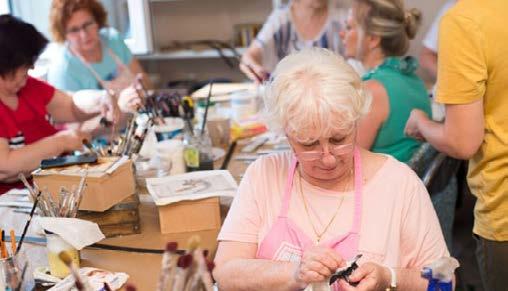
Maria Woodie
In the fast-paced world we live in, endless errands, innumerable emails, and relentless to-do lists demand our attention. But finding time to break away every now and again to unwind is crucial if we want to keep growing as artists. One way to unwind and renew is through art workshops and retreats. Stepping back from the demands of everyday life can inspire leaps in creativity. Art workshops and retreats help us not only to enhance our artistry but also work on ourselves, too.
In Remembrance of Things Past, Marcel Proust’s great tome about the creative life, memory is a key theme, and reflection is presented as a necessity for art. The often deplorable Baron de Charlus wisely castigates the narrator, who is restless to leave. There are experiences missed in always rushing and
advantages in taking time, in being present. The narrator is young and won’t heed this advice for many pages and years, but the advice remains, waiting for the stillness that will recognize its value.
Artists need time to withdraw from the hustle of life in order to attend to the needs of the creative voice within. That time apart provides the platform for individual ideas that lead to new artistic visions.
Art workshops and retreats began to appear at the turn of the 19th century as if in response to the growing urban centers, the rumble of industry and the increasing pace of life. In 1900, the German poet Rainer Marie Rilke wrote, “How large the eyes become here!” upon his arrival at Worpswede, the artists’ colony founded in the German town of that name just a year
earlier. That same year, the now-famous artists’ residency, Yaddo, in Saratoga Springs, N.Y., declared its mission to provide “rest and refreshment [for] authors, painters, sculptors, musicians and other artists, both men and women.” These retreats offer a quiet space for artists to do their work without the demands of even so much as cooking a meal. Able to think only about their particular pursuit, artists have the freedom to explore without mundane constraints.
Black Mountain College offers another model for retreat. Founded in 1933 on John Dewey’s holistic educational principles that emphasize democracy, the college saw a generation of artists develop there, including Josef and Anni Albers, Willem and Elaine de Kooning, and Cy Twombly. Feeding off one another’s conversations and schemes, few ever wanted to graduate. Their relationships and shared projects inspired works for decades.

Destination art workshops can offer a similar opportunity to work on projects and hear the ideas of other committed artists over meals and drinks. A novel environment allows different perspectives to arise. New friends with similar passions provide support, and an instructor helps guide ideas to life. A week or two in Italy or a few days in a nearby community can invigorate creative channels dried by daily toil. A change of air refreshes, while a different altitude or latitude reveals new qualities of light. The chance to get away allows the eyes to widen and review what is possible.
For some, a seasonal or annual refuge is necessary. As people meet and connect at art workshops, they form communities and encourage one another. They often insist upon a regular retreat; some groups have reunited for decades. Both the location and the participants protect the artistic spirit against the demands of daily life that make that spirit easy to ignore. Other artists may find they prefer solitude and seek out retreats that foster introspection and quiet reflection.

The Shenandoah Art Destination (Virginia) attracts artists of all skill levels and allows them to work on their own or in groups. Instruction, offered in drawing, painting and printmaking, is individualized based on each participant’s needs and goals.
The creative voyage, however, need not require a trip. The spirit of retreat is there when we carve time to be alone. Whether in the studio or on a walk, time apart fosters the energy and drive to produce work. To insist upon a period away from the requests of others—from the hassles and strains in the turmoil of tasks and jobs—is a challenge because of the commitment it entails on the artist’s life. Others may not understand, and their responses feel belittling; however, the walls of the studio become thicker with time and criticisms less meaningful. The slow and steady work accumulates. Projects grow. Skills develop. Persistence permits us to become present.
The concept of retreat stems both etymologically and spiritually from the need to pull back. No doubt, this is the first and most valuable understanding, but I also like to think of the word as an opportunity to gift oneself again: to re-treat. When the world is a bother, a quiet refuge to make art is better than ice cream. Art workshops and retreats, therefore, can fill a spiritual need while also permitting a personal indulgence. Only through tending to the self can artists produce the work they offer the world. It may be five minutes, five hours or five days, but only through retreat can someone stop rushing to the next thing and take the personal time necessary to arrive as an artist.
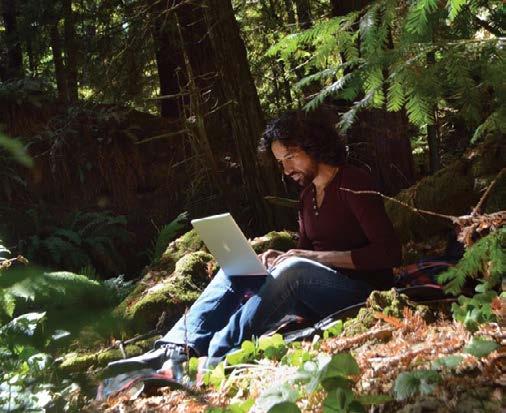

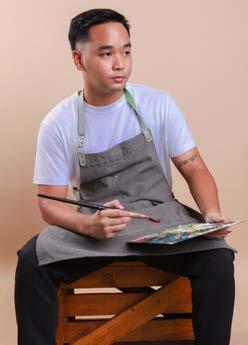
Jan Leonard Faraon is a young, confident, and exceptionally talented Filipino artist who has been capturing the hearts of art enthusiasts with his remarkable works. Polite and well-spoken, Jan has a natural ability to present himself with grace and confidence.
Jan's artistic journey began at the tender age of 14 when he first picked up a paintbrush and discovered his passion for creating art. His early works primarily focused on traditional subjects such as landscapes and still life, which showcased his keen eye for detail and his ability to bring scenes to life on canvas. These initial explorations laid a solid foundation for his burgeoning career as an artist.
As Jan's skills evolved, so did his artistic vision. Today, he is in a phase of exploring the world and beauty of contemporary art, experimenting with different mediums and tools to expand his creative horizons. This transition marks an exciting chapter in his career, as he delves into new styles and techniques that challenge and inspire him to push the boundaries of his artistry.
Jan is a proud member of the Kulay ng Pitong Lawa Art Group, a collective of artists dedicated to promoting and nurturing the local art scene. His
involvement with this group has provided him with invaluable opportunities to collaborate with fellow artists and participate in various exhibitions, further honing his craft and gaining exposure for his work.
In addition to his artistic pursuits, Jan currently works as a Gallery Manager at Studio 88, where he is responsible for curating exhibitions, managing gallery operations, and promoting the works of other artists. His role at the gallery not only allows him to immerse himself in the art world but also to contribute to the growth and development of the local art community.
Jan's dedication to his craft and his passion for art are evident in every piece he creates. His paintings are a true reflection of his personality—a determined and passionate young man who always strives for excellence in everything he does. His respect for tradition and his openness to contemporary influences come together to create works that are both timeless and innovative.
As Jan continues to explore and grow as an artist, he remains committed to his goal of motivating viewers to discover their relevance in society through his art. His journey is a testament to the power of creativity and the impact that a dedicated and passionate individual can have on the world. Jan Leonard Faraon's story is one of talent, determination, and an unwavering commitment to excellence. As he forges ahead on his artistic path, there is no doubt that he will continue to inspire and captivate audiences with his exceptional work.
—Ingrid Aimee Peñaflor
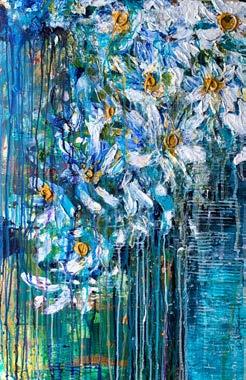




Manuel “Manny” S. Sinquenco, born in the serene town of Tanay, Rizal in 1972, is a testament to how passion, perseverance, and dedication can transform one's life. The son of Jaime Hucom Sinquenco, a master carpenter, and Lydia Buizon Samonte, a devoted housewife, Manny's early life was marked by simplicity and hard work.
Manny’s journey in art began in his childhood. He completed his elementary education at Tanay Elementary School in 1985 and high school at Sierra Madre Institute in 1989. Despite the financial constraints of his family, Manny’s father always encouraged him to use his artistic talents to build a better future. Inspired by this advice, Manny dedicated himself to honing his skills as a painter.
After high school, Manny joined the Tanay artist group in 1989. His early works were showcased in the group exhibition "Likhang Tanay" in 1990, featuring watercolor paintings on unconventional media like old papers and Philippine currency. This period marked the beginning of Manny’s journey in the art world.
From 1992 to 1996, Manny's work was exhibited in galleries such as Alegria Gallery, Felicidades, Discovery Gallery, and Heritage Art Gallery. During this time, he focused on miniature canvases, painting old houses with intricate details reminiscent of Araceli Dan’s watercolor style. His paintings were well-received and sold successfully.


Manny’s breakthrough came in 1998 when his painting "Sisikapin Ko" became a finalist at the Philip Morris Group of Companies Philippine Art Awards. This piece depicted a boy with paintbrushes, symbolizing Manny’s own aspirations and struggles as an artist. This recognition boosted his confidence and visibility in the art community.
In 2006, Manny held his first solo exhibition titled "Deep Colors, Changing Hues, New Point of View" at the Philippine Heart Center in Quezon City. The exhibition featured seventy-two paintings of still life, landscapes, and modern abstracts, showcasing Manny’s versatility and evolving style. Influenced by Pipo Alcantara, Manny began to develop his unique style, blending elements of abstract, cubism, and comic illustration.
Manny’s dedication to his craft and his unique approach to painting old and modern houses against picturesque backdrops soon earned him the favor of art enthusiasts. His signature subjects, often sun-drenched or set in moonlit nights in the hillside village of Tanay, became highly popular.


Over the years, Manny has received numerous awards: - *1982-1983*: First place in on-the-spot drawing and poster-making contests at Tanay Elementary School. - *1988-1989*: First place in poster-making at Sierra Madre Institute and Painter of the Year award. - *1991*: Finalist at Metrobank Art Company. - *1998*: Finalist at the Philippine Art Awards, Philip Morris Group of Companies. - *2006*: Best Solo Exhibit of the Year by the Philippine Heart Center. - *2016*: Awarded Natatanging Pintor na Tagataguyod ng Sining - Biswal by BAKUSI foundation.
Manny has participated in numerous exhibitions and competitions: - *1990*: Exhibit at San Ildefonso Church, Tanay, Rizal. - *1991-1992*: Sining at Paskuhan Painting Exhibit of Rizal Artist. - *1993*: Kulay Luntian Five Man Show Art Exhibit, BF Homes, Parañaque. - *1998*: Philippine Art Awards, Glorieta, Makati. - *1999*: Likhang Tanay exhibit, PNB Financial Center, Pasay. - *2000*: Kulay Tanay, Estilong Binangonan Group Exhibit, Gallery Nissan Family Center, Makati City; Sari-Saring Ilustrasyon Group Exhibit, SM City North Edsa, Quezon City. - *2001*: Sigla 2001 Group Exhibit, Tanay, Rizal. - *2003*: "Dama De Luna," featured in various exhibits and published in a book by Manuel Duldulao. - *2006*: First individual exhibit at the Philippine Heart Center, Quezon City. - *2007*: Back to Back exhibition with Bati at Village Art Gallery, Alabang Town Center. - *2014*: Second solo exhibit "Old World by Manuel Sinquenco," Art Circle Gallery, EDSA Shangrila Mall, Quezon City.
- *2015*: 25th Anniversary Group Exhibit of Art Circle Gallery, Art Center Megamall, Mandaluyong City.*2016*: BAKUSI Group Exhibit. - *2017*: Group exhibit in San Francisco, California with The Tanay Artist.*2018*: Sining Rizal Group Exhibit at Globe Building, BGC. - *2019*: Artblast Group Exhibit, Megamall Art Center. - *2020*: PENANG Intercultural Exhibition, Island Art Gallery, George Town, Malaysia; Solo exhibit "Digital Tour Nostalgic Fragment," Art Circle Gallery.*2021*: Virtual collaboration exhibit "Beyond Imagination, Imagination Creates Reality." - *2022*: Group exhibits in Unimart Gallery, Estancia Mall, GSIS, and book launches of "Philippine Art and Beyond" and "Philippine Modernism." - *2023*: International group exhibits in Perak, Malaysia and Penang, Malaysia; book launch of "Filipino Artist, Their Culture, Their Art."
- *2024*: Book launch of "Palette of the World, " international group exhibits, and various group exhibits in the Philippines.
Beyond his personal achievements, Manny has contributed significantly to the art community. His participation in various group exhibits showcases his collaborative spirit and his commitment to promoting Filipino art. Manny’s works are characterized by a blend of traditional and contemporary styles, often depicting scenes of everyday life in the Philippines. His ability to capture the essence of Filipino culture and heritage through his art has made him a beloved figure in the local art scene.
Manny’s art is not just about aesthetics; it’s a reflection of his life and experiences. His paintings often tell stories of struggle, hope, and perseverance, resonating with many who view them. His dedication to his craft and his ability to innovate while staying true to his roots have set him apart from his peers.
Manny is a dedicated husband and father. Despite his busy schedule, he always makes time for his family. He is known to be a good friend, always looking out for his group members during exhibits abroad. His sense of humor and down-to-earth nature make him a joy to be around. Manny’s simplicity and humility are evident in the way he interacts with others. He remains grounded despite his success, always acknowledging the support and encouragement he has received from his family and friends.
Manny is also a devout individual, with a strong faith in God. This spiritual aspect of his life is often reflected in his art, where themes of faith and resilience are prevalent. His belief in a higher power guides him in his personal and professional life, providing him with strength and inspiration.
Manny’s journey has not been without challenges. The path to becoming a recognized artist is often fraught with difficulties, from financial constraints to the constant pressure to innovate and improve.


However, Manny’s perseverance and passion for his craft have seen him through these tough times. His ability to turn obstacles into opportunities is a testament to his resilience and determination.
One of the significant challenges Manny faced was gaining recognition in the competitive art world. Despite his talent, breaking into the art scene required more than just skill; it required persistence and a willingness to continuously evolve. Manny’s success is a result of his relentless pursuit of excellence and his ability to adapt and grow as an artist.
Manny’s influence extends beyond his artwork. He is a mentor to aspiring artists, often sharing his knowledge and experiences to help others grow in their craft. His journey from a young boy in Tanay to a recognized figure in the art world serves as an inspiration to many. Manny’s story is a reminder that with hard work, dedication, and a bit of faith, it’s possible to achieve great things.
Manny’s legacy is one of passion, perseverance, and dedication. His contributions to the art world and his impact on the community are lasting. As he continues to create and inspire, Manny remains a vital part of the Filipino art scene, a beacon of creativity and resilience.
Manuel “Manny” S. Sinquenco’s journey from a young boy in Tanay to a recognized artist is a story of passion, perseverance, and dedication. His unique style and dedication to his craft have earned him a special place in the Filipino art scene. Manny’s life and work continue to inspire many, proving that with hard work and dedication, dreams can indeed become reality.
Manny’s story is not just about his achievements as an artist; it’s about his journey as a person. His dedication to his family, his commitment to his craft, and his resilience in the face of challenges are qualities that make him an exceptional individual. Manny’s life is a testament to the power of perseverance and the importance of staying true to oneself.

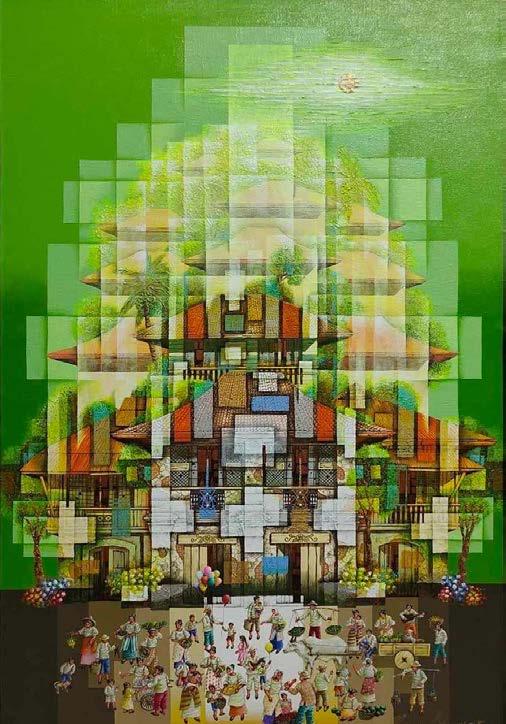
Pauline Allison F. Espinosa stands as a beacon of artistic talent within the rich tapestry of Filipino artistry. Born into a family where creativity flows through the veins, she is the daughter of the esteemed Filipino painter and publisher, Roy Espinosa, and her mother Irma Fariñas Espinosa, a fine arts graduate. This familial artistic lineage has undeniably shaped Pauline's journey as an artist.
Despite her academic pursuit leading her to a degree in Hotel and Restaurant Management, Pauline's heart gravitated toward the canvas. Her father's influence, evident in the strokes of his own brush, and the creative legacy embedded in her family history, ignited a passion that would become an intrinsic part of her identity.
In the day-to-day, Pauline assumes the role of a full-time barista, weaving her artistic aspirations
seamlessly into the fabric of her daily life. This duality of existence — navigating the structured world of hospitality while nurturing the boundless realms of creativity — defines Pauline's unique narrative.
Pauline's art dances with color, a symphony of hues that reflect the vivacity of her Filipino heritage. Vibrant and daring, her brushstrokes breathe life into canvases that capture the essence of her surroundings. Nature, with its ever-changing moods, and the ephemerality of everyday scenes, serve as her muse. Landscapes, seascapes, and still lifes become the canvases for her emotional expression, each stroke resonating with a sense of dynamism.
Beyond the shores of her homeland, Pauline has ventured into the international art scene, exhibiting her works alongside her father's. These exhibitions serve not only as a testament to her artistic prowess
but also as a bridge between cultures, connecting hearts through the universal language of art.
Her exhibitions have received acclaim, critics applauding the distinctive style that sets her apart. The synergy between bold strokes and a nuanced understanding of composition reveals an artist who is not only technically adept but deeply attuned to the subtleties of the human experience.
For Pauline, art is not a profession but a profound means of self-expression. It is a dialogue with the world, a silent conversation where emotions find resonance in color and form. Her journey as an artist is not defined by accolades but by the sincerity with which she approaches the canvas, a sincerity that resonates with those who encounter her work.
As Pauline continues to navigate the dual realms of hospitality and artistry, her story unfolds as a testament to the enduring power of creativity. In her paintings, one glimpses not only the beauty of the Philippines but also the soul of an artist who, despite the demands of reality, dares to dream in vibrant pigments. Her narrative is a living canvas, a testament to the timeless dance between tradition and innovation that defines Filipino art.
—Ruth Espinosa

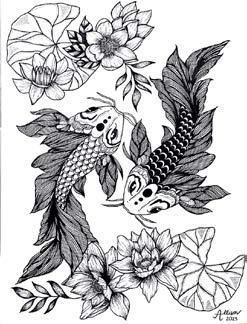

Billy Israel A. Yu stands at the intersection of artistry and business acumen, holding a bachelor's degree in business administration with a focus on marketing. As an artist, Yu's creative journey is a testament to his commitment to pushing boundaries and exploring the dynamic interplay between geometric abstraction, expressionism, and cubism.
Yu's style is a captivating fusion of precision and innovation, where geometric forms come to life on the canvas. His meticulous use of pointed and curvilinear shapes, coupled with varying outlines, creates a visual language that invites viewers into a realm of structured complexity. Each brushstroke seems purposeful, contributing to a larger narrative of shapes and colors that dance harmoniously.
The artist's background in business administration adds an intriguing layer to his artistic persona. This duality of skills is reflected in the strategic composition of his works, where each element seems to be carefully arranged, much like the components of a successful business plan. Yu's ability to seamlessly merge the analytical with the expressive sets him apart in the contemporary art landscape.
In the absence of specific artworks, Yu's overarching style becomes the focal point of discussion. His commitment to geometric abstraction allows for a dynamic exploration of form and space, echoing the pioneering spirit of artists like Picasso. The canvases become a playground for visual experimentation, where shapes transcend their conventional meanings, and colors weave a narrative that is both introspective and inviting.
As an artist with a background in business administration, Yu brings a unique perspective to the canvas. His ability to navigate the structured world of business and seamlessly translate it into the fluidity of artistic expression is a testament to his versatility. In a world where art and commerce often seem like disparate realms, Yu's work serves as a bridge, inviting

audiences to appreciate the harmony that can exist between the two.
Billy Israel A. Yu's artistic journey is not just a visual spectacle but a testament to the harmonious marriage of precision, innovation, and a nuanced understanding of both the artistic and business worlds. His style becomes a canvas in itself—a dynamic exploration of geometric forms and a celebration of the symbiotic relationship between structure and creativity.
Throughout his career, Yu has consistently pushed the boundaries of his artistic practice. His works are characterized by their intricate detail and thoughtful composition, each piece a reflection of his deep understanding of both artistic principles and business strategies. This unique blend of skills allows Yu to create art that is not only visually compelling but also deeply meaningful, resonating with viewers on multiple levels.
Yu's dedication to his craft is evident in the meticulous detail and precision of his works. His approach to art is both analytical and expressive, a testament to his ability to balance the structured world of business with the fluidity of artistic expression. This duality is what sets Yu apart in the contemporary art landscape, making his work a compelling fusion of art and commerce.
In conclusion, Billy Israel A. Yu is a visionary artist whose work bridges the gap between the structured world of business and the fluid realm of artistic expression. His commitment to geometric abstraction and his ability to infuse his work with both precision and innovation make him a standout figure in the contemporary art scene. Yu's work serves as a testament to the power of blending analytical and creative skills, inviting viewers to appreciate the harmony that can exist between art and commerce.



By: Simon Peñaflor
I think people often underestimate the power of art. Throughout history different artforms have made an impact to the world, an impact that changed the entire history of one’s nation forever. In music you have songs like Sam Cooke’s “A change is gonna come”, Johnny Cash’s “What is Truth?”, and Kendrick Lamar’s “Alright” just to name a few. Songs that discuss topics that are on people’s minds, but they don’t have a louder and stronger voice to talk about it, songs that empower people and stand up for what’s right and voice out the wrongs, songs that changed people’s views and opinions, songs that impacted not only the charts, but the world.
In the Philippines, there’s no other example that I can think of other than Juan Luna’s Spoliarium, a painting that was so great, it made an entire nation gain confidence in themselves, ultimately sparking a revolution. A revolution that changed the entire history of our nation. Luna created a painting that reflected the cultural and political context of the Philippines during its colonial period, a mixture of both realistic art and representational art. Juan Luna’s balanced composition technique tells a story beyond the canvas, the longer you stare at the painting, the more you see, further diving into the story behind it, the painting is much larger than visual arts.
Two Filipino artists had won prizes at the National Exhibition of Fine Arts in Madrid in 1884. Felix Hidalgo won a silver medal with his painting “The Christian Virgins Exposed to The Populace”, and Juan Luna won his first ever gold medal with his notorious Spoliarium. An Asian subject became triumphant out of every Spanish artist in the competition, which was incredible news especially for the Filipino nationalists who were looking for signs to fight against the claims that they were the inferior race. Rizal said that the artwork is a representation of “spirit of our social, moral
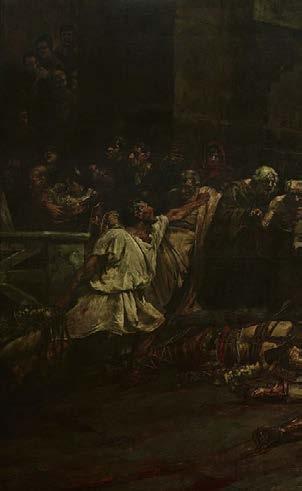
and spiritual life, humanity subjected to trials unredeemed, reason in open fight with prejudice, fanaticism and injustice.” Lopez Jeana said in his speech after Luna had won a gold medal, “The Philippines is more than a veritable Spoliarium with all its horrors. There it lies in mangled fragments, humanity massacred, the rights of man perverted. There is no semblance of justice for the common man and liberty is cinders, ashes, and dust.”
I had been fortunate enough to visit the national museum of the Philippines and see the painting personally many times, the first time that I visited was when me and a couple of my friends had an early dismissal time in class and decided to visit the museum instead of doing our usual habit of playing video games at a friend’s house which was nearby our school. At the time I had heard about the famous painting but had no idea that it could be seen at the museum. My first reaction was that I was shocked about how large the painting was, to this day it probably is and probably will be one of the largest paintings

that I had personally seen. An enormous painting, measuring at 7.7, by 4.2 meters. It’s a dark image, both in its color and tone and its subject matter itself. From a far the painting gives off a sinister aura, but once you take a closer look, you can see the beauty behind the dark energy that the painting carries. It depicts a Spoliarium, which is a Latin word that refers to the basement of the Roman Colosseum, where fallen and dying gladiators were dumped. From there the gladiators would be stripped from their armor and weapons. A lot can be seen going on in the painting, first and the main highlight is the dead bodies being dragged in the middle of the composition. You can tell that Luna wanted the viewer to look right in the middle of the painting where this subject can be seen, this scene is where the painting has the lightest tone, it’s where the vibrant of the red can be noticed the most. After staring at the dead gladiators your eyes begin to wander to the left where you can see scavengers, possibly searching for something to loot off the dead gladiators, a man is pushing another man away. Further to the left of the painting is personally my
favorite part of the entire piece, you can see a crowd going up towards a staircase. There’s something about that crowd in the staircase that I just found myself being drawn to. On the right of the painting the scene becomes even more grim as we see a woman mourning a death of a gladiator, maybe it was her husband or her son. A man is searching for someone in the pile of the dead bodies, maybe his son, or his brother. The painting not only visualizes the death and suffering of those who fought and lost, but also the suffering of the ones they loved. Something to think about all of this is, all this death and suffering that is happening throughout the painting was avoidable. Perhaps, Luna was comparing Roman cruelty with Spanish cruelty, comparing Rome’s violent imperialism with Spain’s violent colonialism, a world full of senseless death. It presents a behind the scenes image of both the cruelty and the bloodshed of an empire, and it’s portrayed by a colonial subject, the talent and genius of which not even his colonial masters could deny.

by Ingrid Aimee Peñaflor
On December 8, 2024, the vibrant atmosphere of Paraiso de Avedad in San Pablo, Laguna, transformed into a world of colors and creativity as the international art exhibition "Colores de la Vida 2024" officially opened its doors. This much-anticipated event, which runs until December 15, showcases the remarkable works of artists from various countries, including Korea, Indonesia, Malaysia, Thailand, Vietnam, Germany, Nepal, Taiwan, the USA, and Romania, alongside talented Filipino artists.
The stunning gallery at Paraiso de Avedad, built specifically for this exhibition by owners Ret. General Romeo Sta. Ana and Mrs. Charlene Fule Sta. Ana, is a testament to their commitment to art and culture. Every inch of the gallery reflects elegance, with Mrs. Sta. Ana personally curating the details, ensuring a perfect blend of style and functionality. This
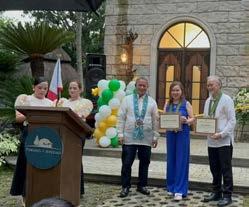
dedication sets the stage for artistic dialogue and the celebration of diverse cultures.
The opening day was a remarkable experience filled with warm camaraderie. Guests were greeted by the beautiful melodies of a string orchestra, filling the air with enchanting music that perfectly complemented the art on display. The harmonious sounds created an inviting atmosphere where local and foreign artists mingled, sharing their thoughts and inspirations. These conversations sparked creativity and fostered connections, highlighting the universal language of art that transcends boundaries.
One of the most captivating aspects of the opening was the showcase of traditional Filipino cultural dance. Performers delighted the audience with the lively "Tinikling," a dance that involves skillful movements around bamboo poles. The energy and rhythmic footwork captivated viewers, offering a glimpse into the rich cultural heritage of the Philippines. Additionally, a choir serenaded the guests, elevating the experience with melodic renditions of beloved songs that resonated with both local and international audiences.
"Colores de la Vida 2024" is not just an exhibition; it is a collaboration between Paraiso de Avedad, Kulay ng Pitong Lawa, and Filarts, uniting different artistic communities under a single mission: to celebrate life through art. The event emphasizes the importance of cultural exchange, as artists from various nations come together to exhibit their work and to share their stories.
As the days unfold, visitors to the exhibition can immerse themselves in an array of styles and expressions, reflecting each artist's unique perspective on life, love, and culture. From vivid paintings to intricate sculptures, every piece invites viewers to engage in a dialogue about the human experience, extending an invitation to reflect on the beauty that surrounds us in our daily lives.

The "Colores de la Vida 2024" exhibition is a beautiful reminder of the power of art to unite people from different backgrounds and foster understanding in an increasingly connected world. By celebrating diversity and creativity, this exhibition not only honors artistic talents but also serves as a platform for cultural appreciation, making it a truly significant event for both the local community and the international art scene.


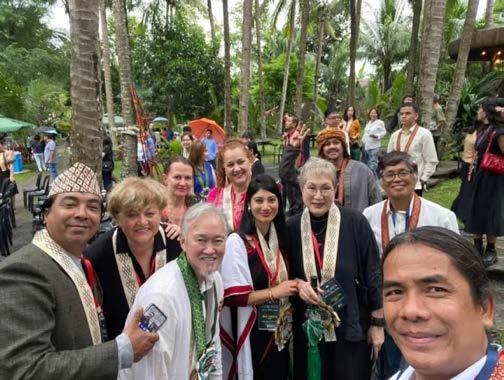




by Ingrid Aimee Peñaflor

In the picturesque town of Paraiso de Avedad, San Pablo, Laguna, a vibrant celebration of art and culture took place from December 8 to 15, 2024. The Colores dela Vida 2024, a one-week international art exhibition, brought together artists from around the world to share their passion for creativity and forge new connections in a welcoming environment. Among the many highlights of the event, one thing stood out - the genuine warmth and hospitality of the Filipino people. The foreign artists, hailing from different corners of the globe, were charmed by the flavors and aromas of


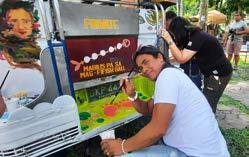
traditional Filipino cuisine. They eagerly savored adobo, sinigang, buko pandan, forming bonds over shared meals and discovering the joy of culinary exploration.
As the days went by, new friendships bloomed amidst the vibrant art displays and cultural performances. The artists exchanged ideas and techniques, each one inspired by the unique perspectives and styles brought by their international counterparts. The exchange of artworks was not just a transaction, but a symbol of mutual respect and admiration for each other's talents.
The heartwarming spirit of camaraderie extended beyond the exhibition halls, as the artists ventured into the Avedad Community to immerse themselves in the local way of life. They visited local galleries, explored the town's hidden gems, and engaged with residents who welcomed them with open arms. The artists were enamored by the rich


tapestry of Filipino culture, from the colorful festivals to the deep-rooted traditions that define the spirit of the community.
The artists found solace and inspiration in the tranquil surroundings of Paraiso de Avedad, where lush landscapes and serene waters provided a backdrop for their creative endeavors. The beauty of nature intertwined seamlessly with the vibrant hues of their artworks, reflecting the harmony and balance they found in this idyllic setting.
As the week drew to a close, the artists bid farewell to their newfound friends with bittersweet smiles and promises of future collaborations. They left with hearts full of gratitude for the warm welcome they received and a deeper appreciation for the Filipino hospitality that had touched their souls.
Colores dela Vida 2024 was not just an art exhibition; it was a celebration of life in color, a tapestry woven with threads of friendship, culture, and creativity. In the heart of Paraiso de Avedad, art transcended boundaries and united diverse souls in a shared love for beauty and expression. And as the last echoes of laughter and music faded into the sunset, the legacy of this unforgettable week lived on in the hearts of all who were fortunate enough to be a part of it.


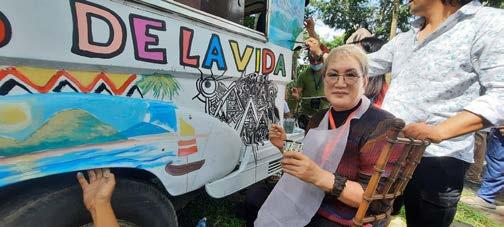

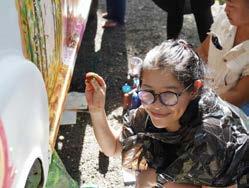






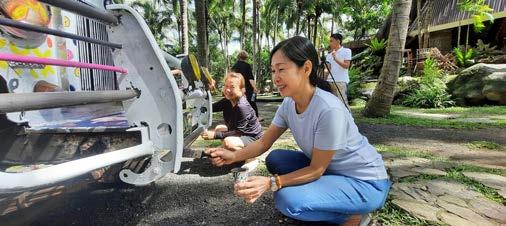





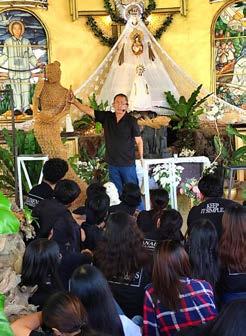
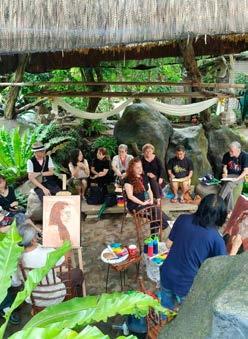

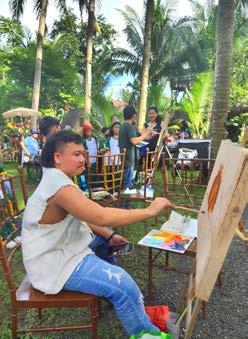

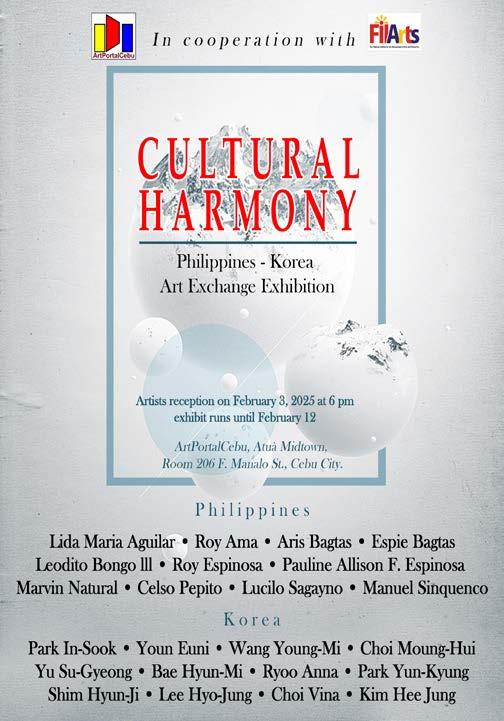

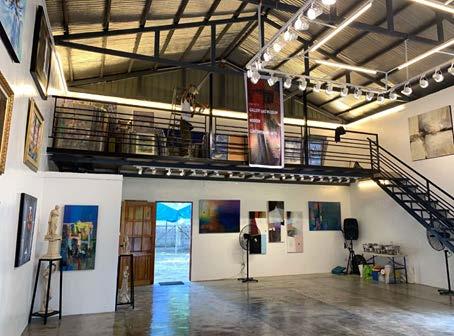
The Museum and Gallery
Is dedicated to collecting, preserving, and interpreting developments in the late 19th century to post-World War II art through 1970’s (Modern Art) and 1970’s to the present (Contemporary Art) in all media and creating a welcoming environment for its public appreciation. The Museum promote understanding and interest in art and artists through art shows and exhibitions, curatorial research and publications, and a variety of educational programs, including lectures, guided tours, and workshops.
The Museum is an organic, changing place. Although all the works seen are part of our permanent collection, in order to show the full range of our holdings - over 2,000 objets d’art - and to accommodate important temporary exhibitions, certain works must occasionally be taken off view.
Modern Art
Modern Art includes artistic work produced during the period extending roughly from the 1860s to the 1970s, and denotes the styles and philosophy of the art produced during that era. The term is usually associated with art in which the traditions of the past have been thrown aside in a spirit of experimentation. More recent artistic production is often called contemporary art or postmodern art.
Contemporary Art
Contemporary Art is the art of today, produced in the second half of the 20th century or in the 21st century. Contemporary artists work in a globally influenced, culturally diverse, and technologically advancing world. Some define contemporary art as art produced within “our lifetime”.
Free Admission
Come Visit Us by Appointment
Mon - Fri: 10am - 4pm Sat, Sun and Holidays: Closed
Moncada - Alcala - Bayambang National Road (Arboleda Street) San Pedro Ili, Pangasinan, Philippines
museumgallery.ph@gmail.com
Some of the collections hanging on the wall of the museum
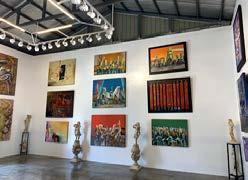
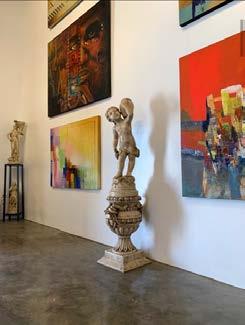


N
estled in the bustling Robinsons Novaliches, Level 1 of the Expansion Building, Gallery Brewed Cafe by Filarts is a delightful haven for art enthusiasts and coffee lovers alike. This charming spot seamlessly blends the worlds of fine art and exceptional coffee, creating an atmosphere that is both inspiring and relaxing.
Gallery Brewed Cafe was conceived with a simple yet profound idea: to create a space where people can enjoy the finest coffee while being surrounded by the beauty of local artwork. The cafe is a testament to the belief that art and coffee share a special connection. Both have the power to evoke emotions, spark creativity, and bring people together.
As you step into Gallery Brewed Cafe, you are greeted by the warm aroma of freshly brewed coffee and the sight of carefully curated artworks adorning the walls. The ambiance is a perfect blend of cozy and contemporary. Comfortable seating arrangements invite you to sit back and unwind, whether you are there to work, catch up with friends, or simply enjoy some quiet time.
The decor is thoughtfully designed to complement the artworks on display. Soft lighting highlights the intricate details of the paintings, sculptures, and photographs, creating a visual feast for the eyes. The overall atmosphere is one of calm and creativity, making it an ideal spot for reflection and inspiration.

At Gallery Brewed Cafe, the coffee is as much a work of art as the pieces on the walls. The cafe prides itself on serving high-quality brews made from carefully selected beans. Whether you prefer a classic espresso, a creamy cappuccino, or a refreshing iced latte, there is something on the menu to satisfy every palate.
The baristas at Gallery Brewed Cafe are passionate about their craft. They take great care in preparing each cup, ensuring that every sip is a delightful experience. The menu also includes a selection of teas, smoothies, and delectable pastries, making it a perfect spot for a light snack or a leisurely brunch.
One of the standout features of Gallery Brewed Cafe is its commitment to showcasing local talent. The cafe regularly hosts exhibitions featuring the works of Filipino artists. This not only provides a platform for emerging and established artists to display their creations but also allows visitors to immerse themselves in the vibrant art scene of the Philippines.
Each piece on display tells a unique story, reflecting the diverse cultural heritage and contemporary experiences of the artists. From striking abstract paintings to evocative photographs, there is
always something new and exciting to discover at Gallery Brewed Cafe.
Gallery Brewed Cafe is more than just a place to enjoy great coffee and beautiful art. It is a community hub where people can connect, share ideas, and be inspired. The cafe often hosts events such as art workshops, live music performances, and book readings, creating a lively and dynamic space where creativity thrives.
The friendly staff and welcoming atmosphere make everyone feel at home, whether you are a regular patron or a first-time visitor. Gallery Brewed Cafe is a place where conversations flow as smoothly as the coffee, and where each visit is an opportunity to experience something new.
Gallery Brewed Cafe by Filarts at Robinsons Novaliches is a charming and unique destination where art and coffee come together in perfect harmony. It offers a serene escape from the hustle and bustle of daily life, providing a space to relax, reflect, and be inspired. Whether you are an art lover, a coffee aficionado, or simply looking for a cozy spot to unwind, Gallery Brewed Cafe is sure to delight your senses and lift your spirits.

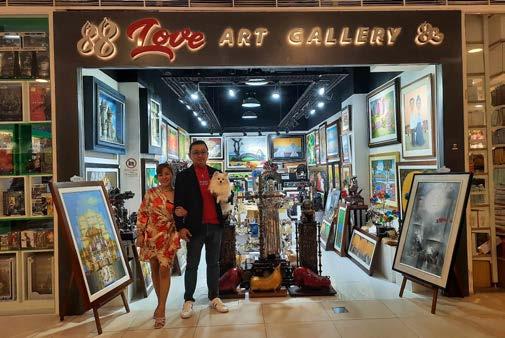
Nestled within the bustling UP Town Center, 88 Love Gallery has become a prominent destination for art enthusiasts and collectors alike. Owned by J. Petchoy Morales III and Aubrey Fernandez, this gallery has quickly gained a reputation for showcasing unique and captivating artworks. Established on May 8, 2023, with the help of Fernan Fernandez, Bernard Fernandez, Francis Fernandez, and Aiza Fernandez, 88 Love Gallery has proven to be a thriving entrepreneurial venture.
J. Petchoy Morales III, the brainchild behind 88 Love Gallery, never anticipated becoming a gallery owner. He started his journey as a collector, with a passion for acquiring exceptional pieces of art. The monumental turning point in his life came when he purchased Jun Martinez's exquisite painting, " Ang Alaga." This was not only the beginning of his art collection but also the beginning of a beautiful relationship with Aubrey Fernandez.
Aubrey Fernandez, sister to the talented Fernandez brothers who own the esteemed Impression

Gallery, unknowingly stumbled upon Petchoy on the very day he purchased his first painting. It was in this serendipitous encounter that a deep connection was formed between the two art aficionados. This newfound partnership became a driving force behind the establishment of 88 Love Gallery.
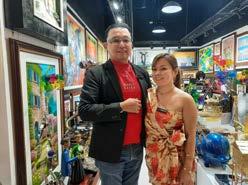
Drawing from Petchoy's experience as a car dealer for over two decades, his gallery and car business have developed a symbiotic relationship. The success of his automobile enterprise, Auto "R" Us, has allowed Petchoy to invest in his passion for art, showcasing some of his personal collections within the gallery. This unique blend of art and automotive offers visitors an eclectic experience, drawing admiration from both art enthusiasts and car enthusiasts alike.
88 Love Gallery boasts an extensive collection of artwork, carefully curated to satisfy diverse artistic

tastes. From contemporary paintings to abstract sculptures, visitors are treated to a myriad of artistic expressions. The gallery's dedication to featuring emerging artists ensures a platform for upand-coming talents to showcase their work, fostering a vibrant artistic community.
In addition to its impressive collection, 88 Love Gallery hosts regular exhibitions and events, providing a dynamic platform for artists to interact with art enthusiasts. These events not only allow patrons to
appreciate the art displayed but also provide an opportunity for artists to share their creative process and inspirations. This engenders an immersive and engaging experience within the gallery, encouraging a deeper appreciation for art.
Since its inception, 88 Love Gallery has garnered a steady stream of visitors and positive feedback. The collaborative efforts of Petchoy Morales III, Aubrey Fernandez, and their dedicated team have laid the groundwork for a flourishing art hub. With the support of Fernan Fernandez, Bernard Fernandez, Francis Fernandez, and Aiza Fernandez, the gallery continues to thrive, delighting both art connoisseurs and newcomers to the art scene.
88 Love Gallery has undoubtedly left an mark on the art landscape of UP Town Center. It serves as a testament to the power of passion, collaboration, and serendipitous encounters. As the gallery embarks on its journey towards further growth and innovation, art enthusiasts eagerly anticipate what captivating pieces and experiences it will bring forth in the years to come.
—Ingrid Aimee Peñaflor
